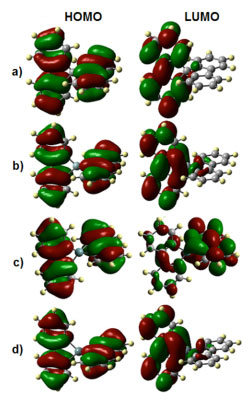Substituted Fluorenones
Over the last several decades the field of organic electronics has exploded with research dedicated to application of molecular and macromolecular organic materials in electronic devices such as light emitting diodes, field effect transistors, and photovoltaics. The development of these organic devices generated a great deal of interest in synthesizing new materials, through low-temperature wet-chemical synthetic protocols, that are soluble in organic solvents. This solution-processibility allows the use of methods such as ink-jet printing and aerosol spray in device production, and reduces fabrication costs relative to their solid-state material counterparts. At the core of all of this burgeoning research lies the fascinating electronics of the organic materials being used within these devices.
In 2000 the Nobel Prize in Chemistry was awarded to Alan Heeger (a physicist), Alan G. MacDiarmid and Hideki Shirakawa for their pioneering work in the development of conducting polymers. This achievement not only highlighted the impact of conducting and semiconducting polymers on the scientific community itself, but also the intimacy of the relationship between chemistry and physics in the development of better performing, better understood polymeric materials. Progress in this field has historically been placed on the shoulders of a small number of workhorse skeletal structures upon which small chemical changes are made with the aim of rectifying a specific problem associated with that material. The results of the change in structure are then studied experimentally and at times theoretically.
Our approach to developing new materials involves performing preliminary theoretical research into new structures before synthesis is begun. This research allows us to use computational chemistry to predict electronic and optical properties of the materials that we will then synthesize and evaluate. In using this approach, we are able to make larger more synthesis-intensive changes to the materials, with a firm idea of the properties we should observe in the proposed novel material.
The current focus of this research is the maximization of charge transfer states in spirobifluorene derivatives through incorporation of electron-rich elements at the spiro-center. The goal of these modifications is to introduce σ-conjugation effects to an existing spiro-conjugated system. Through altering the electronics at the spiro-center we aim to increase the probability of accessing long-lived charge-transfer states in these materials- an effect that would be beneficial to materials for polymer photovoltaic applications.
Students who join this research team enjoy the benefits of an expansive range of tools that they can use to conduct their research including computational chemistry, organic synthesis, catalysis, small molecule and polymer characterization, thin-film evaluation, and device engineering.

